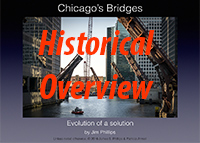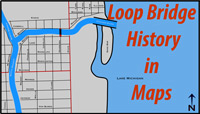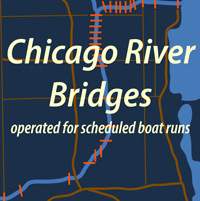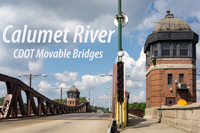N. Wabash Avenue bridge - opened December 20, 1930

Wabash Avenue bridge adapted from a 1930 engineering drawing (courtesy of CDOT Department of Engineering)

Wabash Ave. bridge the day after the greening of the Chicago River 2015
The Wabash Avenue bridge opened to traffic on December 20, 1930. The bridge was built to ease traffic congestion that was especially heavy on the neighboring bridges at Michigan Ave. and State St. during the 1920's. The bridge joined Wabash Ave. on the south bank with Cass St. on the north bank of the Main Stem.
Initially proposed in 1925, plans called for the bridge to connect to a multilayer street system on the north bank of the river. This planned street was similar in purpose and extent to Wacker Dr. on the south bank. Funding issues prevented full completion of this north bank roadway.
Because Wabash Ave. and Cass St. were not directly across the river, the bridge joining the two streets needed to cross the river diagonally. Due to the location and channel width requirements this bridge had the longest trunnion-to-trunnion span of any downtown bridge until the Columbus Dr. bridge was opened in 1982.
Construction began in September of 1929 and the bridge opened to traffic about 15 months later at the end of one of Mayor Thompson's signature parades. As described in the Chicago Daily Tribune: “...the celebration was made the occasion for political speeches to the scores of city hall pay rollers who had ridden in the parade.”
The workings of this bridge are similar to the other second generation Chicago-type bridges built downtown. The beaux arts bridge houses and the rail-height trusses satisfied the aesthetic sensibilities of the the Chicago Plan Commission and impressed the American Institute of Steel Construction (AISC).
The AISC named the Wabash Ave. bridge the most beautiful steel bridge costing more than $1 million built in North America during 1930. In awarding the prize, the jury of architects and engineers observed, the bridge is “a most pleasing solution of a most difficult bridge design problem.” The plaque on the bridge was unveiled on October 21, 1931. This bridge was the first of four Main Stem bridges to receive an AISC award.

The Wabash Ave. bridge marks the end of the involvement of some key players in the planning and design of Chicago's downtown bridges. The Wabash Ave. bridge plaque is the last to include the names E. H. Bennett, T. G. Pihlfeldt; and Mayor William Hale Thompson.
E.H. Bennett was co-author of the 1909 Plan of Chicago and worked as the consulting architect for the Chicago Plan Commission until 1930. His education at the Ecole des Beaux-Arts in Paris influenced his architectural sensibilities. His signature design elements on Chicago's bridges are the bridge houses, railings, staircases, and abutment facades of all twelve downtown bridges built between 1913 and 1930.
An immigrant from Norway, bridge engineer T. G. Pihlfeldt worked in the Division of Bridges of the Chicago Public Works Department from 1894 until his death in 1941. He was involved in the planning and design of fifty-six movable bridges during his forty-seven year tenure with the city. That number included eleven of the downtown bridges built between 1913 and 1930.
William Hale Thompson was Chicago's colorful and generally corrupt mayor from 1915-1923 and 1927-1931. While there was a four year break in his tenure, he managed to be in office while ten downtown bridges were opened. Bridge openings during his tenure were marked with large parades and splashy celebrations.
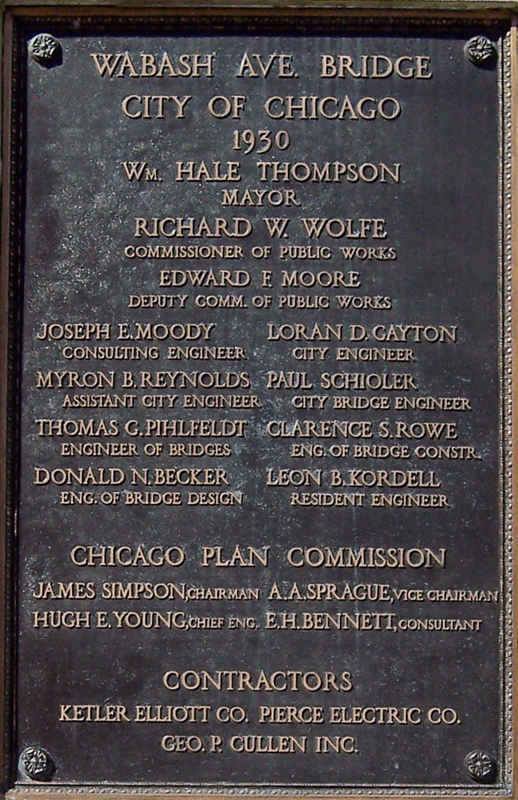
Searching through old newspapers for articles about an eighty-five year old bridge yields a number of stories. Three of these bear repeating.
Vessels ramming bridges on the Chicago River were not unusual during the many years of Port of Chicago traffic passing through the city. One of the more memorable collisions for the Wabash Ave. bridge came in November of 1932. A two hundred foot freighter christened the Alfred H. Smith, rammed the bridge.
The freighter was near the end of its twenty-eight day journey delivering sugar refined in California to a warehouse in Chicago. The freighter's pilot had signaled the bridge operator to raise the bridge, but the electric motors used to raise the bridge failed to operate. By the time the operator was able to notify the pilot of the bridge problem, it was too late to avoid impact. The bridge sustained damage to the sidewalk and the freighter ended up with a 2 foot hole in its prow. Damages to the bridge and vessel were not serious enough to close either the bridge or hinder delivery of the cargo.
An account of a pedestrian riding on a Wabash Ave. bridge leaf appeared in the April 5, 1961edition of the Chicago Daily Tribune.
The bridge leaves had been raised and almost lowered after a vessel had passed. A second vessel signaled before the bridge was completed lowered, so the operator raised the leaves again. A commotion ensued outside the bridge house which included the fire boat and a hook and ladder fire company. The operator thought the activity involved a search in the river unrelated to the bridge operation, so he continued his duties by lowering and locking the bridge. Once the bridge was down, the Tribune describes the action: “a man calmly stepped from his perch on a girder which had carried him some 50 feet into the air, and continued his walk across the bridge.” The man found himself unable to get across or get back when the bridge gates were lowered so he just got on the girder and rode it out. The man was on his way to work at the Sun-Times building and summarized his reasoning saying “It could have made me late for work.” (The Sun-Times building was razed in 2004 for the Trump tower.)

A number of the downtown bridges have been named to honor Chicagoans. The plaque officially naming the Wabash Ave. bridge the Irv Kupcinet bridge was dedicated in a ceremony on June 5, 1986. “Kup's Column” ran for almost 60 years in the Chicago Sun-Times. In his column published on dedication day he commented:
“I NEVER realized how beautiful the Wabash Avenue bridge is until the City Council adopted a resolution to give the structure this reporter's name. I just took another look at it and can report it's positively magnificent. … And it is appropriate that the bridge spans the Chicago River, which runs backward and thus is typical of this reporter. I now make my first pronouncement concerning the bridge. I plan to erect tollbooths at each end. No Longer will you be able to walk or drive over Irv Kupcinet for free.”
Happy 85th to one of Chicago's beautiful bridges!
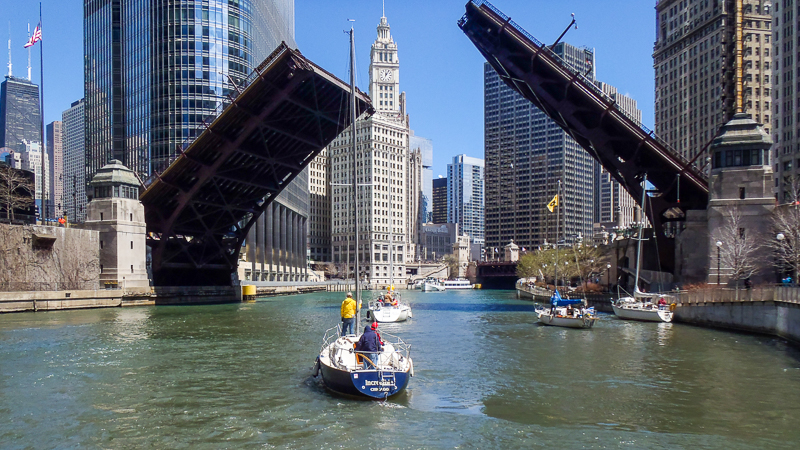
Wabash Ave bridge open for a spring boat run
*****
Sources
Wabash Avenue bridge favored by land owners, Feb 3, 1925
Wabash bridge begun; speeds Cass projects Sep 22, 1929
Wabash bridge opened to loop traffic, Dec 21, 1930
New Wabash Ave. bridge is awarded prize for beauty, Jun 16,1931
Unveiling Oct. 21, Sep 27, 1931
Steamship rams Wabash Avenue bridge, Nov 4, 1932
Sugar arriving by water due to low prices, Nov 5, 1932
T.G. Pihlfeldt is dead at 82, Jan 24, 1941
Pedestrian up in air as scow raises bridge, Apr 5, 1961
All of the above from ProQuest Historical Newspapers Chicago Tribune (1849-1986)
Kup's Column, June 5, 1986 Chicago Sun-Times, Inc
Chicago River Bascule Bridge, Wabash Avenue, HAER IL-48 Addendum, June 1999, Matthew T. Sneddon

